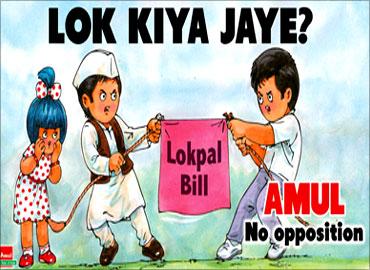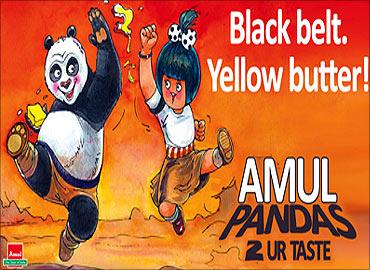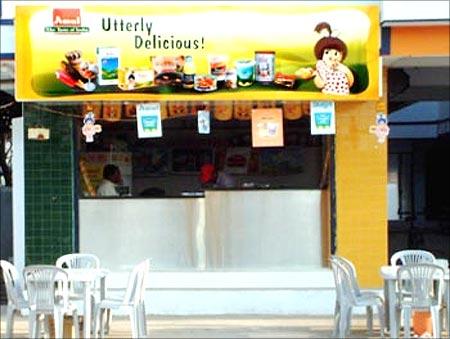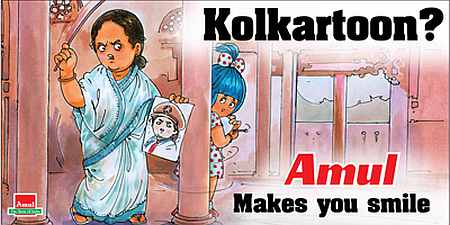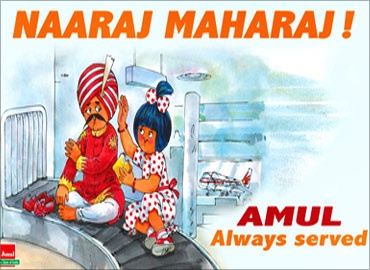 | « Back to article | Print this article |
The story behind Amul's 'utterly butterly' ads
The ads represent a history of modern India acted out by a little heroine, healthy and confident about the future.
It was 1966.
The advertising for a product called Amul butter was assigned to an agency of which I was the manager.
The butter had been in the market for about 10 years.
It was positioned as, 'processed from the purest milk under the most hygienic conditions by a dairy co-operative in Gujarat'.
This was like a lantern lecture to an indifferent audience.
Click NEXT to read further. . .
The story behind Amul's 'utterly butterly' ads
Nonetheless, it had left some positive impressions about the brand.
But clearly, some pep needed to be injected into the communication.
For a start, we needed a tag line to replace 'Purely the Best'.
A new slogan dropped out of the sky when I told my wife Nisha about our new ad assignment.
She spontaneously remarked, 'Why don't you say "Utterly Amul.'
To which I added, 'Hey, what about, "Utterly butterly Amul!"'
Click NEXT to read further. . .
The story behind Amul's 'utterly butterly' ads
And so was coined a slogan that became one of the more memorable battle cries in advertising.
But the word 'butterly' initially met with some scepticism.
'It's ungrammatical,' objected a few.
But Kurien, head of Amul, said, 'I think it's utterly mad; but if you think, it'll work, go ahead.'
So there we had a very promising selling line. What we now needed was a spokesman to voice it.
But who?
Click NEXT to read further. . .
The story behind Amul's 'utterly butterly' ads
Instinctively, I sensed it should be a child, someone impish and lovable.
I explained this to my then art director, Eustace Fernandes, a brilliant visualiser and cartoonist.
After a few tries he came up with this charming little poppet in a polka-dotted frock and a matching ribbon in her pony tail.
She was licking her lips as though to say, 'Utterly butterly delicious.'
Yes, she had all the qualities I was groping for -- she was naught, cuddly, innocent, smart; I knew we had a winner.
The lassie and here line first appeared on a few lamppost boards in Mumbai. The public response was immediate: 'How cute!'
Click NEXT to read further. . .
The story behind Amul's 'utterly butterly' ads
So we decided to build an outdoor campaign around her.
Hoardings as a medium are impactful if the locations are well chosen and the message compelling.
Our very first display presented the missy praying by her bedside: 'Give us this day our daily bread -- with Amul butter.'
The feedback was very positive.
During the horse-racing season came 'Thoroughbread,' with a small jockey holding a slice of buttered toast.
During the monsoons: 'Pitter-patter, pick-a, pack-a Amul butter.'
Click NEXT to read further. . .
The story behind Amul's 'utterly butterly' ads
Calcutta in the 1960s was in the grip of hartals, with processions yelling 'Cholbe na!' ('Will not do!').
We turned that around to: 'Bread without Amul -- cholbe na, cholbe na.'
It drew a smile from many die-hard Leftists.
Slowly, we found we were exploiting situations which were current.
But topical ads pose a challenge.
They need to appear immediately after the issue breaks out; else they lose their immediacy.
But the logistics of releasing an ad ordinarily took time.
Kurien, an inspiring client, immediately saw the need to cut corners.
Click NEXT to read further. . .
The story behind Amul's 'utterly butterly' ads
He told us that we were free to operate without obtaining his okay.
That was a rare gesture indeed, and it reflected his unique way of going about things -- the same uniqueness that made him the father of the milk revolution.
Kurien did, however, caution us not to step on people's toes, 'If you get into trouble because of your ads, be prepared to face the music by yourself.'
But when we sometimes ruffled feathers, he stood by us.
For instance, during a prolonged airline strike, a little uniformed airhostess said: 'Indian Airlines serves Amul butter -- when it flies.'
A furious airline demanded the immediate removal of the ad or threatened to stop serving Amul butter.
Click NEXT to read further. . .
The story behind Amul's 'utterly butterly' ads
Kurien barked, 'The ad stays. No one's going to tell me how to run my advertising.'
There have so far been over 4000 utterly-butterly hoardings.
This is probably the only campaign in the world with the theme and style unchanged in nearly 50 years.
You might say that the ads represent a history of modern India acted out by a little heroine, healthy and confident about the future.
The author is the chairman of daCunha Communications. In 1966, he co-created the Amul butter hoarding campaign.
Excerpted from Amul's India, a book by DY Works and published by Collins Business
